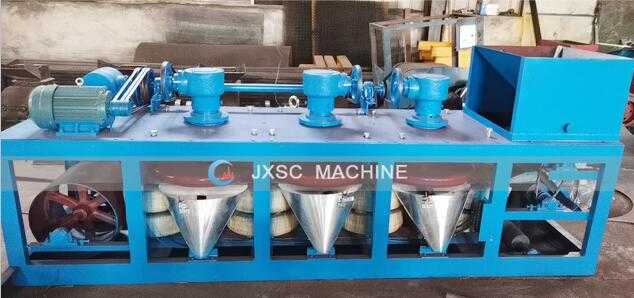Mining magnetic separator is common equipment in mineral processing. And magnetic separation is the main method of iron ore dressing.
What minerals are required for magnetic separation? Common Iron Minerals are magnetite (strong magnetic minerals), hematite (weak magnetic minerals), Limonite, specularite, siderite (all weak magnetic minerals). They are raw materials for the steel industry. The iron ore grade is low, many impurities. Therefore 80% above iron minerals need magnetic separation. Manganese minerals such as psilomelane, pyrolusite, and Rhodochrosite also have weak magnetic properties and are usually recovered by magnetic separation. Ilmenite, Wolframite, Monazite, and niobium-tantalite are all weakly magnetic minerals. Also used magnetic separation.
Non-metallic minerals need to remove iron, titanium, and other mineral impurities except magnetic minerals. Magnetic separators are also needed. So what are the types of mining magnetic separators? JXSC mining equipment manufacturer will introduce the types of mining magnetic separators in detail as follow.

According to the magnetic properties of minerals, magnetic separators are divided into dry magnetic separators, wet magnetic separators, high-intensity magnetic separators, weak intensity separators, permanent magnetic drum separators, and electrostatic mineral separators. The permanent drum magnetic separator, three-disc dry magnetic separator, magnetic roll separator, low-intensity dry drum magnetic separator, and electrostatic mineral separator are widely used in mineral magnetic separation.
Permanent Drum Magnetic Separator
Permanent drum magnetic separator can dry and wet magnetic separation. wet drum magnetic separator feeding materials from the bottom, but dry drum magnetic separator feeding materials from the top.
Wet Permanent Magnetic Drum separator is a kind of magnetic separator often used in iron ore concentrators. It is suitable for separating high magnetic minerals. According to the different structure of the tank, it can be divided into three types: downstream type, counter-current type, and semi-counter-current type.
The sizes of magnetic separators with three types of troughs are as follows: downstream troughs ≤6 mm, reverse troughs ≤1.5 mm, and semi-reverse troughs ≤0.5 mm.
- The downstream magnetic separator has a large processing capacity and is suitable for the rough separation and cleaning of the stronger magnetic materials with a coarser size.
- The counter-current magnetic separator is suitable for the coarse and sweeping operation of fine-grained and strong magnetic minerals, with high recovery but low concentrate grade.
- The counter-current type magnetic separator is not suitable for dealing with coarse materials because coarse materials are easy to deposit and block the magnetic separation space.
- The semi-countercurrent magnetic separator can obtain high-quality iron concentrate and better recovery. Therefore, the semi-countercurrent magnetic separator has been widely used in production practice. It is suitable for the treatment of ore particles less than
0.5 mmof coarse and fine.
Three-Disc Dry Magnetic Separator

The three-disk dry magnetic separator is suitable for the separation of various magnetic mineral mixtures. According to the magnetic difference of the minerals, separated the minerals efficiently by adjusting the excitation current of each stage disk to form different intensity magnetic field. It can also adjust the induction distance between the magnetic disk and the ore particles to get different magnetic field induction intensity, to achieve a one-time separation of many minerals. This equipment is widely used in dry separation of Ilmenite, monazite, and other magnetic and non-magnetic minerals. The three-disk magnetic separator has reasonable structure, small occupied area and simple operation and maintenance.
Magnetic Roller Separator

High intensity dry magnetic roller separator with a fixed magnet having high field intensity and gradient. High-intensity magnetic separator is to lower the content of ferrous contaminants in non-magnetic materials or upgrade the ferrous minerals. It is for dry magnetic separation, with great magnetic intensity, it is suitable to treat weakly magnetic minerals.
How to buy magnetic separator? and what about it’s price?
Here are five questions we need to know:
- capacity
- what mineral
- mineral composition and ratio before concentration (sample test report is preferred)
- how much grade is required after selection?
- what is the feed size?
